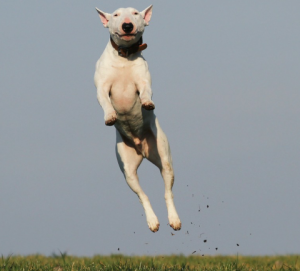Probably the most common behavioural “problem” in dogs is inappropriate jumping. This can either be jumping at you, the owner; or at visitors to the house; in either case, it can be really frustrating and embarrassing! 
Why does my dog jump at my visitors?
To control this behaviour, it’s important to understand why dogs do it in the first place. In the vast majority of dogs, there are two main drivers for jumping – firstly, a desire for attention; and secondly, that they have inadvertently been trained to do it.
Most dogs crave attention; and jumping up is a way to try and interact with you on your level (i.e. 3 or 4 feet above their heads when they’re standing on the ground!). This is especially an issue when you have visitors – because the chances are, you’re greeting or talking to your guests, and ignoring the dog. Of course, you know that’s because your visitors are only around temporarily, and your dog is a permanent part of the family – but they don’t see things like that. They just see you ignoring them and lavishing your attention on your guests, meaning that they feel left out. Of course, it is quite possible that they want attention from your guests as well!
In addition, most puppies learn early on that jumping (especially balancing on their hind legs) gets them attention. As puppies, this is often in the form of reward (fuss, even treats, as people think that they’ve “learnt a trick”). As adults, this may continue, or their owners may shout at them – but when you’re shouting at your dog, you are still giving them attention, and not ignoring them (which, from their point of view, is worse than being scolded). Our inconsistency here doesn’t help – many people are happy for their dog to jump at them, but not at guests, or when wearing some clothes but not others – but by accepting (or rewarding) any jumping behaviour, they are essentially teaching the dog that jumping at people is acceptable. Dogs are generally poor at distinguishing between those situations when a behaviour is acceptable and those when it isn’t.
There is a third possible reason, although fortunately, it is very rare – it may be a form of aggression towards your guests. If a dog makes warning signals (hackles raised, growling, tail down etc) and these are ignored, they may make mock attacks, that could be misinterpreted as jumping. In this situation, the dog will be showing their teeth, growling and possibly snapping. This is very unusual but is very dangerous if it does occur.
So, jumping up may be seen as a way for your dog to demand attention from you – or from your visitors themselves. Alternatively, it may be because they have learnt that jumping is an appropriate response when they’re excited to meet new people; or because people aren’t responding to their “get out of my home” signals. Whatever the cause, however, it isn’t acceptable behaviour – and the bigger the dog, the less acceptable it will be to your visitors!
So, what can be done to stop it?
If your dog is jumping and showing signs of aggression, stop reading this now and contact a qualified canine behaviourist. This is a potentially dangerous situation and requires professional attention.
However, it is far, far more likely that your dog is attention-seeking and/or excited. In these situations, there are two main approaches to stopping dogs from jumping up. It is vitally important to remember that neither of them involves punishment. Punishing your dog for jumping will, at best, confuse them; and at worst result in a frightened and potentially aggressive dog – this is a recipe for disaster.
The first method is to divert the jumping behaviour into something more appropriate – usually a “sit” command. As the dog gets more and more excited and bouncy, you tell them to sit – and then reward them when they do, with fuss and/or a treat. This way, the dog gets some attention and learns that “sit” is appropriate, but “jump” isn’t. Meanwhile, you can continue to greet and chat to your guests, while your dog sits obediently at your feet…
It sounds great, but it does take some work and practice! Ideally, invite some friends who can regularly visit, and who understand the training you’re doing; they can visit (and even come in/go out/come back in repeatedly while you train your dog).
The other thing you can do (and this is really useful on its own or in conjunction with “sit” training) is to completely ignore your dog whenever they jump. You do, however, reward them when their front feet are on the floor. This way, you are teaching them that jumping does NOT result in attention, but standing on all fours does. Again, having “mock-visitors” will help reinforce the fact that what you’re teaching them is universal – it doesn’t go out of the window when new and exciting people are around!
In both cases, it takes time and patience – but it is more than worth it to teach them suitable behaviour before they knock over your elderly aunt, or squash your young nephew! If you’re struggling, contact a qualified canine behaviourist (our vets will be able to recommend one) who can help.
